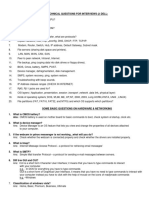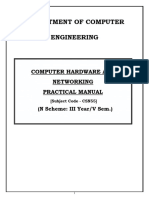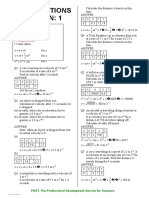Non Voice Tech Ques
Non Voice Tech Ques
Uploaded by
Sai Krishna KodaliCopyright:
Available Formats
Non Voice Tech Ques
Non Voice Tech Ques
Uploaded by
Sai Krishna KodaliOriginal Description:
Copyright
Available Formats
Share this document
Did you find this document useful?
Is this content inappropriate?
Copyright:
Available Formats
Non Voice Tech Ques
Non Voice Tech Ques
Uploaded by
Sai Krishna KodaliCopyright:
Available Formats
Technical Support Interview Questions 2
1. What is BIOS?
Ans: BIOS stands for Basic Input-Output System and is pronounced as Bye-
Ose. The BIOS is available on all the computers. It makes sure that all the
components of the computer can function together. It has information about all the
hardware components in the Computer. BIOS can also be called as a Special Software
that interfaces the major hardware components of a computer with the Operating
System. It is usually stored in a Flash Memory Chip on the Motherboard.
Some functions of BIOS:
1. Performs a POST (Power-On Self Test) for all the different Hardware
Components in the System to make sure everything is working properly.
2. Activating other BIOS Chips on different cards installed in the computer, for
example, SCSI and Graphics Cards.
3. Provides a set of low-level suiting that the Operating System uses to interface
different Hardware devices. BIOS manages things in your computer like the
Keyboard, Monitor, Serial and Parallel Ports especially when the computer is
Booting up.
4. Manage the settings for Hard-disk drives, System Clock etc.
Sequence of things done by the BIOS when you turn on your Computer:
1. Check the CMOS for Custom Settings
2. Load the interrupt Handlers and Device Drivers
3. Initialize Registers and Power Management
4. Perform POST (Power On Self Test)
5. Display System Settings
6. Determine which devices are Bootable
7. Initialize the Bootstrap sequence
2. What are the Hardware Components of a Desktop Computer / Laptop?
Ans: The Hardware Components of a Desktop Computer / Laptop are as follows:
1. The Processor (CPU)
2. Motherboard
3. RAM (Random Access Memory)
4. Power Supply SMPS (Switch Mode Power Supply)
5. Hard-disk Drives
6. CD/DVD-ROM Drives
7. Floppy Disk Drive
8. Sound Card
9. Graphics (Display) Card
10. Keyboard
11. Mouse
12. Monitor
3. What are Hard-Disk Partitions?
Ans: Partitions are used to Divide a Hard-disk drive into smaller segments as
required by the user and for better management of the space in it.
4. Difference between RAM and ROM?
Ans: RAM (Random Access Memory) is used to temporarily store information
that the computer is currently working on.
ROM (Read Only Memory) This is a Permanent type of memory storage used by
computers for important data which never changes. (Example: BIOS)
5. What would you check if there is no sound from your computer?
(Audio not working)
1. Check for cable connections
2. Check for power to the speakers
3. Check for volume control
4. Check for device drivers
6. If a Customer complains that his computer is working really slow,
what are the things you would check?
1. Check if it is taking longer than usual to start up
2. Check if it is slow with one / any particular application or slow overall.
3. Check for Spyware/Malware/Virus in the computer
4. Check the available Hard-Disk Drive Space in the computer.
7. What is the Blue Screen of Death (BSOD)? .
Ans: A Blue Screen of Death (or just a Blue Screen Error) is an indication of a
Critical System Problem wherein the Computer freezes altogether and does not
respond to anything.
To rectify this problem, try Restarting the computer or Booting into Safe Mode. For
more information, read this.
8. Why are Device Drivers required?
Ans: A Device Driver (or just Driver) is a piece of software which is requied to run
every Hardware Component present in the computer.
9. Name one of the latest Computer Processors (CPU) ?
Ans: Intel Pentium Quad Core, Intel I3, I5, I7 processors.
10. What is Ping?
Ans: Ping is a command that checks the connectivity with an IP address. For more
read this article
11. What is a Data Cable?
Ans: A Data Cable is a Thin Plastic band-like cable used to connect the Data-Devices
like Hard-disk drives, Floppy Disk Drives, CD/DVD-ROM drives with the
motherboard. Data Cables are primarily used for Data Transfer.
12. Lights on a Modem / LAN Card:
Ans: Generally, there are 04 lights. They indicate the following:
1. Power Light: Shows if the device (Modem)is getting Power Supply or not.
2. Link Light: Indicates if the device is getting broadband/internet signals properly
from the ISP
3. Data Light: Indicates wether the internet is working or not.
4. Connectivity Light: Indicates the Modem is connected to a PC or not.
13. Name some of the Ports available in a Computer
Ans: Some of the commonly available ports in a Computer are as follows:
1. Keyboard & Mouse Ports Also known as PS/2 ports
2. USB Ports
3. VGA Ports
4. Sound Ports
5. LAN Port Also known as Ethernet Port
14. What does the term USB stand for?
Ans: USB stands for Universal Serial Bus. It allows devices to be connected or
disconnected from a computer without shutting down or restarting the computer.
The current version of USB is 2.0
15.What is the difference between CRT (Cathode Ray Tube) and LCD
(Flat Screen Monitors)?
Ans: CRT Monitors: The Monitor has a picture tube and uses a light-gun to
highlight pixels on the screen.
LCD Monitors: These monitors do not have a picture tube and contain a layer of
liquid crystals on an Electronic Board.
16.What is an IP Address?
Ans: An IP address is a unique numerical identifier of every device on a network. A
typical IP address can look like this: 216.27.61.141. To detect a computers IP
Address, go to Start Run Type in CMD in the Run Dialogue Box and click OK or
hit <Enter> In the Command Prompt Screen that comes up, type in IPCONFIG
and hit <Enter>
17. What is DHCP?
Ans: DHCP stands for Dynamic Host Configuration Protocol. It is used to generate &
provide IP addresses to the computers on a network.
18. What is DNS?
Ans: DNS stands for Domain Name Services it is used to convert URLs into IP
addresses and vice-versa.
19. Mention a sample computer configuration:
Ans:
1. Intel Pentium Core 2 Duo 3.0Ghz
2. 2 GB RAM
3. 300GB HDD
4. DVD Writer
5. 17 inches LCD Monitor
6. Keyboard
7. Mouse
20. Name any Five Microsoft Office Applications:
Ans:
1. MS Word
2. MS Excel
3. MS Powerpoint
4. MS Access
5. MS Outlook
21. What are RJ45 and RJ11 connectors?
Ans: RJ45 connectors are used for LAN/Ethernet connections and RJ11 connectors
are used for Telephone Cable connections.
22.What is a Parallel Windows installation?
Ans: When the first installation of Windows fails to boot for some reason, another
copy of Windows is installed in teh same drive but in a different directory (so that the
customer can access to and backup his old data). This is called Parallel Installation of
Windows.
23.Name some of the versions of Windows XP.
Ans: Windows XP Home Edition, Professional, Media Center Edition, Tablet PC
Edition, Mobile
24.What are the components needed to setup a Basic Home Network?
Ans: LAN Cards, LAN Cables, Router/Hub
25. Difference betwen a WORKGROUP and a DOMAIN?
Ans: In a Workgroup, all the computers function as Peers. But in a Domain, One
computer is the Server and the others are Clients.
26. What is the difference between FAT32 and NTFS file systems?
Ans: 1. NTFS allows compression and file encryption. FAT32 does not. 2. NTFS is
more secure than FAT32
27. What does BOOT.INI do?
Ans: Boot.ini lists all the Operating Systems present in the computer and provide
information about which partitions they are located on.
28. How would you access the Recovery Console in Windows?
Ans: By booting with the Windows XP CD and following the on-screen instructrions.
The Recovery Console can also be installed in your computer.
29. Provide the names of a few Firewalls:
Ans: Norton, McAfee, Zone Alarm etc
30.What feature of Outlook Express allows multiple customers to send
and receive emails, each using a separate account?
Ans: Identities
You might also like
- Desktop Support L1 Interview Questions and AnswersDocument6 pagesDesktop Support L1 Interview Questions and AnswersSatish50% (4)
- Technical Support Interview QuestionsDocument58 pagesTechnical Support Interview QuestionsDonald Miller100% (2)
- Technical IT & Desktop Support Interview Questions and AnswersDocument7 pagesTechnical IT & Desktop Support Interview Questions and AnswerssureshjobiNo ratings yet
- Learn Kannada Through TeluguDocument3 pagesLearn Kannada Through TeluguSai Krishna Kodali40% (15)
- A New Tool For Electro-Facies Analysis: Multi-Resolution Graph-Based ClusteringDocument14 pagesA New Tool For Electro-Facies Analysis: Multi-Resolution Graph-Based ClusteringElok Galih Karuniawati100% (1)
- TP Catalyst DocumentManagerDocument8 pagesTP Catalyst DocumentManagergunawanNo ratings yet
- DL1 Interview QuestionsDocument41 pagesDL1 Interview QuestionsGanesh WarangNo ratings yet
- DL2 Interview QuestionsDocument34 pagesDL2 Interview QuestionsMohammad MudassirNo ratings yet
- Tech Questions For Interview With Answers (3) - 1Document8 pagesTech Questions For Interview With Answers (3) - 1ts.hcltechbee2022No ratings yet
- Possible Questions of Nc2 ExamDocument10 pagesPossible Questions of Nc2 Examlrac_adazolNo ratings yet
- A+ Guide To Hardware, 4eDocument62 pagesA+ Guide To Hardware, 4eepriyaa100% (4)
- Tech Interview Questions: Expand BIOS: A) Basic InputDocument12 pagesTech Interview Questions: Expand BIOS: A) Basic InputSyed Abdul Hafeez0% (1)
- Cpws Ar20 All Units Questions & AnswersDocument80 pagesCpws Ar20 All Units Questions & AnswersSudheerNo ratings yet
- Questions and AnswersDocument95 pagesQuestions and AnswersGlenn SnyderNo ratings yet
- CSN55 CHM ManualDocument34 pagesCSN55 CHM ManualYuva RajNo ratings yet
- Computer Basic 1201Document6 pagesComputer Basic 1201Doinik DorkarNo ratings yet
- Interview Questions TipsDocument3 pagesInterview Questions TipssyahmiNo ratings yet
- Techinical Support L1 Interview Q&ADocument18 pagesTechinical Support L1 Interview Q&AsaikrishnaNo ratings yet
- Act 1 Identifying Computer ComponentsDocument3 pagesAct 1 Identifying Computer ComponentsElaine MagbuhatNo ratings yet
- Computer-Assembly-And-Repair-Lab-Manual 2023 - 202 - 231209 - 093922Document63 pagesComputer-Assembly-And-Repair-Lab-Manual 2023 - 202 - 231209 - 093922Rashmi SameerNo ratings yet
- Computer Assembly and Repair Lab Manual 2023 202 - 231209 - 093922Document63 pagesComputer Assembly and Repair Lab Manual 2023 202 - 231209 - 093922kshigeo102No ratings yet
- Tech QuesDocument4 pagesTech QuesSunshineJagritiNo ratings yet
- Sant Baba Bhag Singh Institute of Engineering and TechnologyDocument104 pagesSant Baba Bhag Singh Institute of Engineering and Technologybaljot90No ratings yet
- OS MID Shaheer Shahzad 025 29052020 042210pmDocument18 pagesOS MID Shaheer Shahzad 025 29052020 042210pmShaheer ShahzadNo ratings yet
- Google IT SupportDocument5 pagesGoogle IT SupportSajeeth Ahamed Abdul RaheemNo ratings yet
- Tech MaterialDocument17 pagesTech MaterialSagar Singh RajpootNo ratings yet
- What Is Computer Systems Servicing (CSS NCII) ?Document12 pagesWhat Is Computer Systems Servicing (CSS NCII) ?Jen PequitNo ratings yet
- Hand Practice On Power On and Power OffDocument9 pagesHand Practice On Power On and Power OffkanikakannuNo ratings yet
- CHN MANUAL ColourDocument13 pagesCHN MANUAL Colourjameshemanth1408No ratings yet
- Trabajo ComputadoresDocument7 pagesTrabajo ComputadoresCristian Aguirre RamirezNo ratings yet
- Desktop Support Engineer Interview Questions and AnswersDocument7 pagesDesktop Support Engineer Interview Questions and AnswersjosephNo ratings yet
- All Chapter CCNA1Document49 pagesAll Chapter CCNA1Driton EmerllahuNo ratings yet
- Computer Hardware ServicingDocument5 pagesComputer Hardware ServicingJamae SantosNo ratings yet
- Sol ch01Document8 pagesSol ch01SunTszuNo ratings yet
- Bab IiiDocument84 pagesBab Iiifajarbanurea3No ratings yet
- Computer HardwareDocument90 pagesComputer HardwareKiran KumarNo ratings yet
- What Is Computer Systems Servicing (CSS NCII) ?Document11 pagesWhat Is Computer Systems Servicing (CSS NCII) ?rezhablo100% (1)
- Computer Hardware Servicing NC II Assesment Free ReviewerDocument6 pagesComputer Hardware Servicing NC II Assesment Free ReviewerMarnel Matunog IwamotoNo ratings yet
- CSN55 CHM ManualDocument19 pagesCSN55 CHM ManualYuva RajNo ratings yet
- Exercise Meeting 2: Following Question 1 - 3Document4 pagesExercise Meeting 2: Following Question 1 - 3Rafael BilliNo ratings yet
- Css Question and AnswerDocument7 pagesCss Question and AnswerAko Si Jhadong100% (1)
- HP Tech Support Interview QuestionsDocument27 pagesHP Tech Support Interview QuestionsBhuvana NNo ratings yet
- Computer Hardware Servicing: Tuesday, October 26, 2010Document6 pagesComputer Hardware Servicing: Tuesday, October 26, 2010Victor Dagohoy DumaguitNo ratings yet
- System Config 311Document10 pagesSystem Config 311Unknown UserNo ratings yet
- Hi NotesDocument14 pagesHi NotesAchsah S. ThomasNo ratings yet
- 11th CS Code - 083 QB-22.06.23Document6 pages11th CS Code - 083 QB-22.06.23manomani007123No ratings yet
- Mid-Term Exam ICTDocument5 pagesMid-Term Exam ICTchandy RendajeNo ratings yet
- Review For Next WeekDocument4 pagesReview For Next WeekBitoy101No ratings yet
- 1) What Do You Know About Computer?: 2) What Is IP Address and Why Is It UniqueDocument3 pages1) What Do You Know About Computer?: 2) What Is IP Address and Why Is It Uniqueakshaym.sspsNo ratings yet
- Technical Interview QuestionsDocument9 pagesTechnical Interview QuestionsJohn GeorgeNo ratings yet
- Interview Questions With Answers For System Admin UpdatedDocument12 pagesInterview Questions With Answers For System Admin UpdatednithinpremdsaNo ratings yet
- Identifying Expansion Module CardsDocument44 pagesIdentifying Expansion Module CardsROSE TASINo ratings yet
- TACN FinalDocument10 pagesTACN FinalNgọc MítNo ratings yet
- Windows OS Questions Basic Input/Output SystemsDocument24 pagesWindows OS Questions Basic Input/Output SystemsDavid NeilNo ratings yet
- Usama Shehu Project CompleteDocument30 pagesUsama Shehu Project CompleteJOSEPH OLUYEMINo ratings yet
- Tech MaterialDocument17 pagesTech MaterialanshulghiyaNo ratings yet
- Lab Manual Computer Organization and Hardware MaintenanceDocument28 pagesLab Manual Computer Organization and Hardware Maintenanceanshroy7373No ratings yet
- Lab 1: What's Inside A PC?: Your Logbook Separately From Your Lab PartnerDocument8 pagesLab 1: What's Inside A PC?: Your Logbook Separately From Your Lab PartnerShadman SifatNo ratings yet
- Ass 2Document5 pagesAss 2api-239676197No ratings yet
- Inter QuesDocument6 pagesInter Quesambrish78659No ratings yet
- Computer102 4 DepedDocument59 pagesComputer102 4 Depednick21070No ratings yet
- Coc#1 3Document4 pagesCoc#1 3Monica FabricanteNo ratings yet
- Bases of Segmentation-Demographic, Geographic, Psychographic & Behavioural Variables Demographic VariableDocument5 pagesBases of Segmentation-Demographic, Geographic, Psychographic & Behavioural Variables Demographic VariableSai Krishna KodaliNo ratings yet
- Essel Group PresentationDocument38 pagesEssel Group PresentationSai Krishna KodaliNo ratings yet
- Network SimulationDocument2 pagesNetwork SimulationsaikrishnakodaliNo ratings yet
- Animatronics: BY B.Kanthaiah Iv EceDocument18 pagesAnimatronics: BY B.Kanthaiah Iv EceSai Krishna KodaliNo ratings yet
- Auto Reset Over or Under Voltage Cutout: Electronics & Communication EngineeringDocument66 pagesAuto Reset Over or Under Voltage Cutout: Electronics & Communication EngineeringSai Krishna KodaliNo ratings yet
- The What, When and How of The GMATDocument5 pagesThe What, When and How of The GMATSai Krishna KodaliNo ratings yet
- Tata 1Document2 pagesTata 1Sai Krishna KodaliNo ratings yet
- Tata 3Document4 pagesTata 3Sai Krishna KodaliNo ratings yet
- Auto Reset Over-UnderDocument1 pageAuto Reset Over-UnderSai Krishna KodaliNo ratings yet
- Sai SeminarDocument2 pagesSai SeminarSai Krishna KodaliNo ratings yet
- Photonics: Photonics Devices & System OverviewDocument17 pagesPhotonics: Photonics Devices & System OverviewSai Krishna KodaliNo ratings yet
- Usr Local SRC Education - Com Files Static Lesson-Plans Superhero-Citizens Superhero-CitizensDocument8 pagesUsr Local SRC Education - Com Files Static Lesson-Plans Superhero-Citizens Superhero-Citizenshannah songNo ratings yet
- The MultitesterpowerpointDocument21 pagesThe MultitesterpowerpointAngel AlarasNo ratings yet
- AstroCel I - Prod - Mark - Broch - AFP 1 110BDocument4 pagesAstroCel I - Prod - Mark - Broch - AFP 1 110Bjonathan Reano MendozaNo ratings yet
- Tps 53603Document24 pagesTps 53603techgamebr85No ratings yet
- Equations of Motion 1 AnswersDocument1 pageEquations of Motion 1 AnswersckNo ratings yet
- CPMG Appendix CDocument9 pagesCPMG Appendix CGuillermo JooNo ratings yet
- Journal Pone 0295078Document14 pagesJournal Pone 0295078ronaaqilahusnaNo ratings yet
- Delta VFD E User Manual PDFDocument403 pagesDelta VFD E User Manual PDFInfoprime CharqueadasNo ratings yet
- Mathematical ModelDocument11 pagesMathematical Modelhasan jamiNo ratings yet
- Torsiona-Flange SAE J744Document3 pagesTorsiona-Flange SAE J744Jamin SmtpngNo ratings yet
- Student Guide - Background PaperDocument3 pagesStudent Guide - Background Paperomba careNo ratings yet
- Sap Budget ProceduresDocument17 pagesSap Budget ProceduresAnonymous ywBR5hF4No ratings yet
- Apc smx3000lv User ManualDocument10 pagesApc smx3000lv User ManualColour BlindNo ratings yet
- Selling ConceptDocument6 pagesSelling ConceptDhurba Bahadur BkNo ratings yet
- Virtual AccountDocument9 pagesVirtual AccountAchal wankhadeNo ratings yet
- Unit Iii MCQDocument9 pagesUnit Iii MCQANKUR CHOUDHARYNo ratings yet
- Academic Collocations 31 To 40Document2 pagesAcademic Collocations 31 To 40Rana SherifNo ratings yet
- Valve Case StudyDocument3 pagesValve Case StudyAnoopNo ratings yet
- Cambridge International AS & A Level: Biology October/November 2023 2 HoursDocument24 pagesCambridge International AS & A Level: Biology October/November 2023 2 HoursZhemaiah OzeNo ratings yet
- Kendalls and Marzanos New TaxonomyDocument22 pagesKendalls and Marzanos New TaxonomyRUTHY ANN BALBIN BEEd 2-1100% (2)
- Forensic Nursing and Indian LawsDocument1 pageForensic Nursing and Indian LawsguruconthiruvallaNo ratings yet
- 1.history of Medical CannabisDocument8 pages1.history of Medical CannabisJulia Paes LopesNo ratings yet
- Heavyduty Kits Catalog 2017Document8 pagesHeavyduty Kits Catalog 2017panamapuro100% (1)
- 1 s2.0 S0360544223005960 MainDocument14 pages1 s2.0 S0360544223005960 MainFrank Joel Herrera ApaesteguiNo ratings yet
- Taylor and Mayo's Schools of ThoughtDocument3 pagesTaylor and Mayo's Schools of ThoughtTharindu Dasun WeerasingheNo ratings yet
- CL - 5 Maths Combined PDFDocument19 pagesCL - 5 Maths Combined PDFTechno Gaming OfficialNo ratings yet
- Humboldt Dissertation VorlageDocument5 pagesHumboldt Dissertation VorlageWriteMyPapersDiscountCodeCleveland100% (1)
- Literacy ToolKIt Author Bradford SchoolsDocument93 pagesLiteracy ToolKIt Author Bradford SchoolsDOA FCLFNo ratings yet





































































































